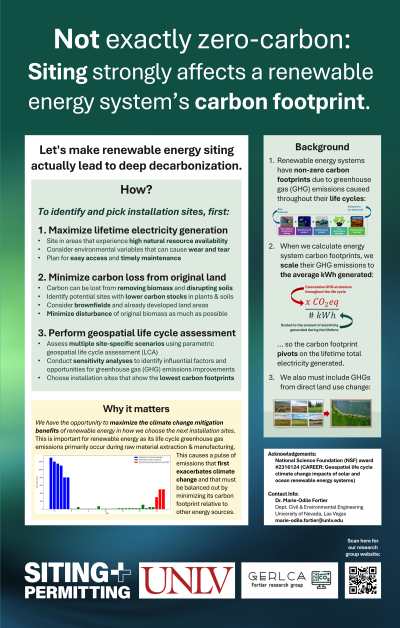Let's make renewable energy siting actually lead to deep decarbonization
Tuesday, April 15, 2025
5:00 PM - 6:00 PM PT
Location: Regency Ballroom


Marie-Odile Fortier, PhD (she/her/hers)
Assistant Professor in Civil and Environmental Engineering and Construction
University of Nevada, Las Vegas
University of Nevada, Las Vegas
Las Vegas, Nevada
Poster Presenter(s)
Presentation Description: Our analyses indicate that over 50% of the greenhouse gas (GHG) emissions associated with our energy transition are simply unaccounted for as governments plan for major investments in energy infrastructure changes. Regional decarbonization or climate action plans in the US do not tend to account for emissions in mining, manufacturing, transportation, maintenance, and waste management activities associated with our current and future sources of electricity. They also leave out any emissions that take place outside of their geographic jurisdictions, but that are caused by their own demands (e.g., imports of electricity from other states), among other omissions that vary from site to site such as direct land use change impacts.
How then can we improve our planning and siting of electricity infrastructure to actually mitigate climate change? We can optimize the energy transition towards the most efficient and lowest carbon footprint systems for different locations, using geospatial life cycle assessment methods and machine learning instead of current practices. Dr. Marie-Odile Fortier will discuss these issues and opportunities in decarbonization planning learned through recent research and why this matters to effective climate action and infrastructure development.
Dr. Fortier (https://marieodilefortier.com/) is faculty in Civil and Environmental Engineering and Construction at the University of Nevada, Las Vegas. She heads the Geospatial Energy Resources & Life Cycle Assessment (GERLCA) research group and develops methodology for geographically-specific decarbonization planning.
How then can we improve our planning and siting of electricity infrastructure to actually mitigate climate change? We can optimize the energy transition towards the most efficient and lowest carbon footprint systems for different locations, using geospatial life cycle assessment methods and machine learning instead of current practices. Dr. Marie-Odile Fortier will discuss these issues and opportunities in decarbonization planning learned through recent research and why this matters to effective climate action and infrastructure development.
Dr. Fortier (https://marieodilefortier.com/) is faculty in Civil and Environmental Engineering and Construction at the University of Nevada, Las Vegas. She heads the Geospatial Energy Resources & Life Cycle Assessment (GERLCA) research group and develops methodology for geographically-specific decarbonization planning.
